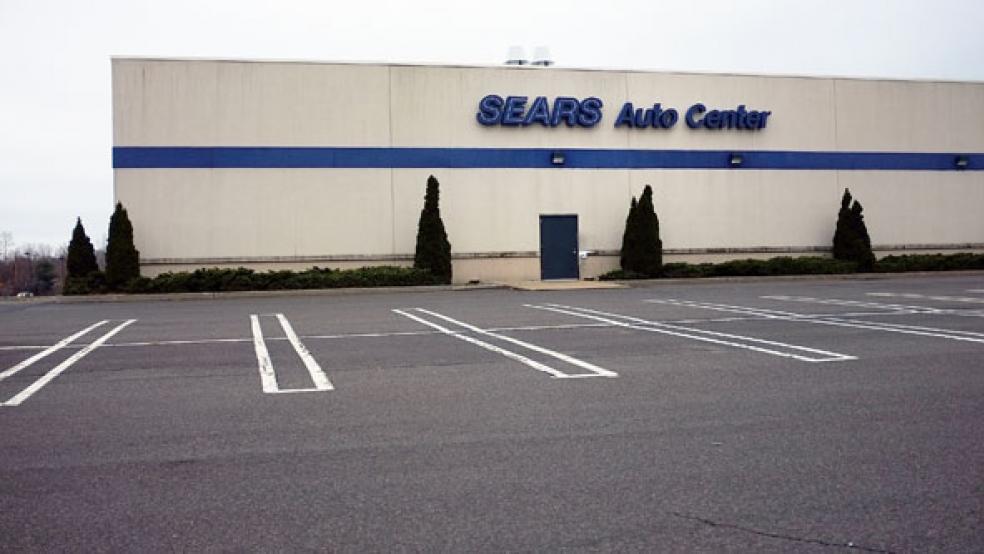Eddie Lampert and the folks at Sears Holdings (NASDAQ: SHLD) may want to send their rivals at J.C. Penney (NYSE: JCP) a big Valentine’s Day gift. If it hadn’t been for Penney’s failed, attention-getting attempts to reinvent itself as a slick, edgy “Apple-ized” department store, the world might have locked in on the slow-motion implosion at Sears long before its recently announced plunge in same-store sales triggered the most recent selloff in the stock.
Now comes news that Lampert and Sears plan to shutter its flagship Chicago store, right smack dab in the middle of the city’s famed Loop area. It’s one thing for them to shutter smaller stores in regional malls, something else again to decide that they can no longer turn a profit on such a valuable piece of real estate. Or at least, that such an iconic location is worth more as real estate to the troubled company than as a place for shoppers to spend money. It's another sad sign that a retailer that has been around some 128 years – surviving world wars, depressions, the arrival of the motor car and the shopping mall – seems prepared to exit the stage with a whimper rather than a bang.
Related: Five Companies That May Not Survive Past 2014
In the eyes of Brian Sozzi at Belus Capital Advisors, Sears seems to be using its stores to generate much-needed cash – cash that, in theory, could assuage any concerns among its suppliers and help convince investors that it still has the resources necessary for a turnaround. “In effect what we are witnessing from Sears is not painful measures taken today to position the company for the future of retail, it’s the company using its stores as a fast cash ATM machine to survive another couple of years,” Sozzi writes.
Store closures alone are hardly going to be enough to stanch the bleeding, though. What’s needed is for Sears to give shoppers a reason to walk through the doors of those stores – and not just to pick over the bones, salivating eagerly at the chance to grab towels, kitchen appliances and toys at 75 percent off.
Plenty of analysts question whether that’s achievable. “Sears has become a philanthropy, not a business,” one skeptical analyst told me last summer. “They’re donating market share to everybody else – including J.C. Penney.” Could Sears be a turnaround candidate, I asked? Not likely, the analyst replied. Nothing that management was doing or saying signaled that they were approaching the problem in the right way.
Consider Home Depot (NYSE: HD) and Macy’s (NYSE: M), both of whose management teams have invested north of $6 per square foot of store space in recent years. Lampert, meanwhile, has forked over about a quarter of that. Just walk into the flagship Macy’s store in New York’s Herald Square to get a sense of what that means; even in regional malls, the Macy’s stores look elegant and welcoming compared to the Chicago flagship of Sears.
To save money, Sears is readying itself to spin off its still-profitable Land's End business. Land’s End is another case of an opportunity squandered: Rather than applying the lessons learned at the boutique retailer to the main department stores, the company ended up eating into the value of the brand by simply making Land’s End apparel available on the shelves at its Sears stores.
Indeed, Sears has avoided pretty much every opportunity to do the right thing when it comes to its turnaround. As industry analysts would say, the folks who get a retailer into trouble are rarely the right people to turn to in order to extricate it from difficulties. So, who did Lampert pick as the new Sears Holdings CEO a year ago? You guessed it: He named himself to the job. That pretty much ensured that he wasn’t going to hear much in the way of criticism coming up the management chain.
One of the elements that helped Home Depot turn around was a big emphasis on people: Hiring the right folks and retraining them, as well as giving them more responsibility. That was part of a broader push to improve merchandise and make shopping a more pleasant experience. In other words, Home Depot recognized that a turnaround involves more than simply cutting costs to the bone.
One of the biggest stock market winners of the last year is Best Buy (NYSE: BBY), whose stock is still trading about 56 percent above where it was a year ago at this time, when investors and analysts were still wary of its own attempts to stage a turnaround. (Not coincidentally, the move has been spearheaded by a brand new CEO from outside the company and the industry, Hubert Joly.)
True, a disappointing holiday season knocked some of the stuffing out of the stock and the company’s turnaround tale, but even critics are grudgingly acknowledging that service has improved and that the company is intent on finding a way to survive as a bricks-and-mortar retailer in an Amazon-driven world of razor-thin profit margins and “showrooming.”
The list of successful bricks-and-mortar turnaround stories in retail may not be long, but it exists. So far, though, there seems to be little reason to suppose that Sears will be joining that list any time soon.
Top Reads from The Fiscal Times:





